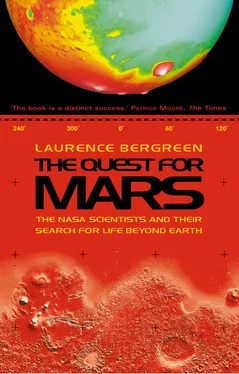He became adept at building a consensus around the selection of a site. He led a site selection workshop at the Johnson Space Center in Houston, fielding ideas from the entire Mars community. They whittled the choices down to about ten, which Matt put on a large, complicated diagram called “The Chart from Hell.” After much study, Matt, working with another geologist, Hank Moore, concentrated on a Martian basin named Chryse Planitia – Chryse Plain. Within Chryse there is an outflow channel called Ares Vallis, the geological legacy of a huge, ancient flood that deposited interesting and varied rocks on the surface. The diverse rocks were the greatest attraction, as far as he was concerned. The area’s sheer size made it very appealing. Pathfinder, in addition to all its other uncertainties, could not make a carefully predetermined landing; if all went well, it would land somewhere within an ellipse 60 miles wide and twice as long. Matt fretted over the temperature range of Ares Vallis, over the distribution of rocks, and especially over the amount of dust blowing around. If you’ve ever come into contact with terrestrial lava dust, you immediately understand the problem. It’s gritty and irritating and clings to the fingers. Martian dust, made from powdered lava, is similarly fine and gritty. It relentlessly clogs machinery and obscures solar panels.
To get a better idea of what Pathfinder might encounter if it landed in Ares Vallis, Matt used an Earth analogue – not Iceland, in this case, but the Channeled Scabland in the state of Washington. This desolate region was formed during a huge flood about 13,000 years ago; the turbulent water redeposited rocks across a flat plain, just as Matt believed had once occurred in Ares Vallis on Mars. The Channeled Scabland is much smaller than the Martian site he was considering, and tufts of grass spring from the soil, but geologically, it is remarkably similar to Ares Vallis. He took several field trips to the Channeled Scabland, and even brought along the rover to see how it would fare on the rock-strewn terrain. It ably negotiated the varied surface, and he figured he had finally found his landing site. Ares Vallis was safe, it was geologically interesting, and it was, he hoped, not too dusty.
NASA’s review panel considered his choice. “You’re going to go back there and kill the spacecraft – and kill your career,” they said, but Matt would not be intimidated. He had seen the results of Pathfinder tests in even worse conditions than it would encounter on Mars, and the spacecraft had survived. “We ended up making the most robust lander that’s ever been designed to land on a planet. Pathfinder could land anywhere,” he told the panel. In the end, Matt got his way, and his landing site on Ares Vallis, but his career would ride on Pathfinder’s fortunes.
4 FROM OUTER SPACE TO CYBERSPACE
The Kennedy Space Center in Florida employs sixteen thousand people and covers over a hundred thousand acres. It includes a wildlife refuge; herons, egrets, condors, crocodiles, horses, and cattle roam its expanses. From the road, you can see a six-foot-wide bald eagle’s nest suspended in the branches of a tree. If you drive in the general direction of the launch pads, away from the animals, you will see the outsized Vehicle Assembly Building, a giant hangar for rocket ships, shimmering through the haze. You can pick out the odd Shuttle transporter here and there; they resemble huge, primitive locomotives with giant cleats. Many of the transporters are rusting in the humidity. In recent years, NASA has built the center into a tourist attraction featuring life-size mockups of the Space Shuttle, a few garish exhibits, and a souvenir emporium. On the outskirts of Titusville, the nearest town, discarded rockets litter front yards like so many abandoned cars, looking nothing like the towers of power that I remember from my youth. A heavy nostalgia for the future lingers over the place like the scent of magnolia on a humid evening, and the marquee in front of the local high school always reads, “Countdown to Graduation – Six Weeks.”
This was where Pathfinder, weighing nearly a ton, arrived on a rainy day in August of 1996. There was a lot of work to do. Things were just beginning to get serious at this point. First thing, engineers wiped down the spacecraft with alcohol to prevent bacteria from Earth contaminating the surface of Mars. Then, electrical technicians wearing bunny suits to prevent dust or hair falling into the delicate machinery, took the spacecraft into a large clean room and tested every circuit. They corrected software problems and installed the rover’s heaters, which contained a tiny amount of plutonium. NASA wasn’t eager to advertise the fact, for the use of nuclear materials in space, even for purely scientific purposes, rouses environmentalists to fury. It was also a giant bureaucratic pain, because NASA had to prepare exhaustive environmental impact statements. The plutonium was deemed necessary because of Mars’ great distance from the Sun. On Mars, sunlight is only a quarter of the strength that it is on Earth, and small solar cells alone could not generate enough power to operate even a small spacecraft and rover.
After the initial preparation, Pathfinder underwent months of additional testing at Kennedy. Often, the tests were more complicated than the actual mission would be. For a test to work correctly, the ground team had to simulate the positioning of the stars and the Sun, the amount of light, and the temperature for Pathfinder, and then program Pathfinder to respond. Nothing went exactly as planned; everything required extra effort. Work became so intense that the young engineers involved with the project didn’t know what to do when they weren’t testing Pathfinder; they sought any distraction available in greater Titusville. They screamed themselves hoarse in a Karaoke bar, they played in mud volleyball tournaments, they surfed, they picnicked in the rain – anything to take their minds off the obstacles they faced to ready Pathfinder for space. At four o’clock one morning, they attended a Shuttle launch. The rocket’s glare turned night into day, and the sound of its engines was powerful enough to make observers’ clothes tremble. Pathfinder’s launch vehicle, a Delta II built by Boeing, was nowhere near as big as the Shuttle’s powerful solid state boosters, but the Shuttle simply attains low Earth orbit, about 350 miles high. It circles the Earth for a few days, and then lands on a nice smooth airstrip. If you happen to be a planetary exploration zealot, Shuttle missions, for all their sound and fury, can be a trifle dull. Pathfinder, in contrast, would travel 309 million miles to reach Mars, following the broad ellipse of its trajectory, and would arrive in a new world.
Whenever they could find a few minutes to spare, Pathfinder’s youthful team members posted their field journals on the Internet. These were casual, subjective reflections on their lives and work, with more questions than answers. The mere act of writing made everyone self-aware. It was weird: they were doing their jobs, and simultaneously, they were watching themselves do their jobs. They were doing their jobs on Pathfinder, and they were watching themselves at the same time. Anyone with access to the Internet could log on and check up on the team members’ psyches. As with so much else on this mission, the plan was very cool, and very un-NASA. Taken together, the team’s written observations sounded like an all-night college dormitory bull session about the meaning of God and life and truth and beauty, and that was their charm. The team members, especially the younger ones, unashamedly asked, Who am I? Where am I going ? The field journals became confessional, a form of therapy. The more enthusiastic correspondents realized something unusual was going on here, something that extended beyond the boundaries of the Pathfinder mission, something that the words “faster, better, cheaper” didn’t begin to convey: a transformation of consciousness . They weren’t just devising a new way to reach Mars, although that was surely foremost in their minds. They were collaborating on a new way to solve problems, to create, to communicate, to imagine.
Читать дальше












